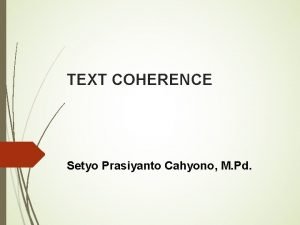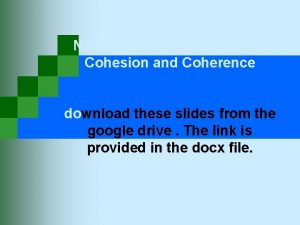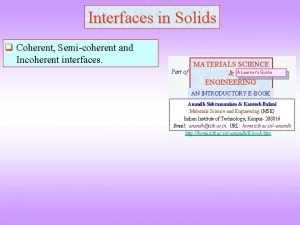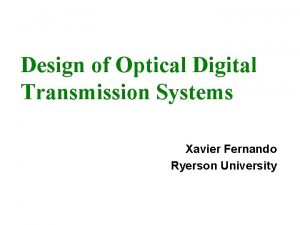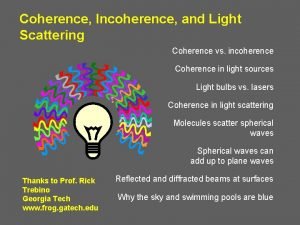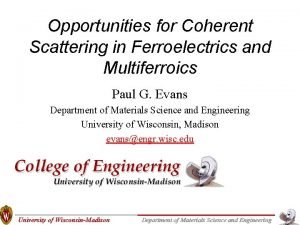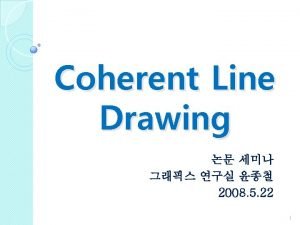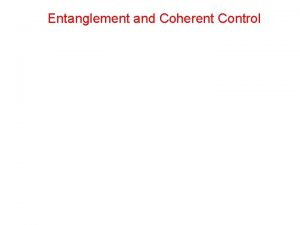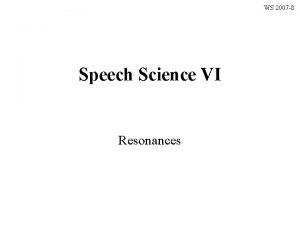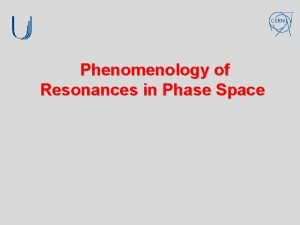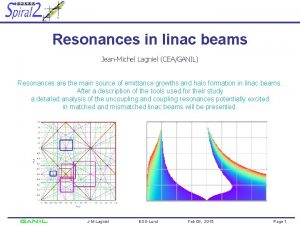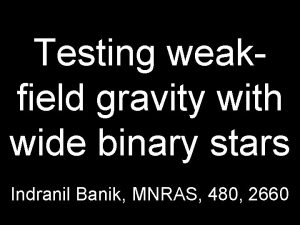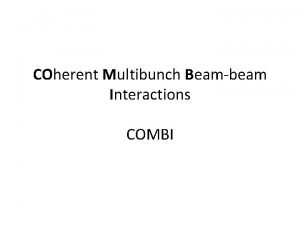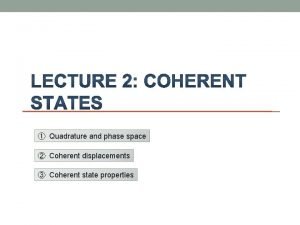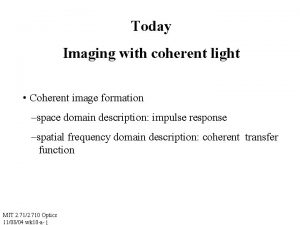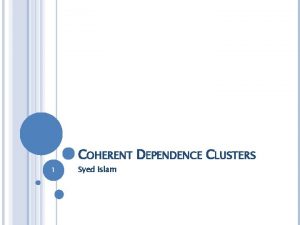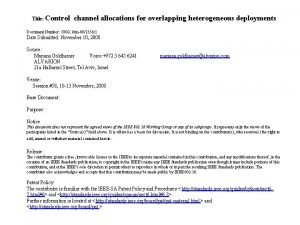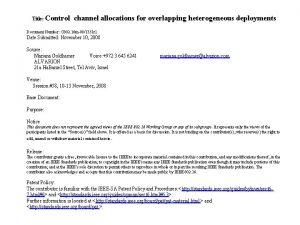Coherent Control of Overlapping Resonances in the WeakField












- Slides: 12

Coherent Control of Overlapping Resonances in the Weak-Field Regime Alberto García-Vela Instituto de Física Fundamental Consejo Superior de Investigaciones Científicas Serrano, 123, 28006 Madrid, Spain 3 rd COST MOLIM General Meeting 2018, Budapest

Motivation A large variety of molecular processes are mediated by resonances o Molecular predissociation (electronic, vibrational, rotational) o Low-temperature molecular reactions o Cold and ultracold nonreactive molecular collisions Control over the behavior of a resonance implies control over those resonance-mediated processes, and this means control over o Resonance lifetime o Fragment state distribution produced upon resonance decay The use of weak-field control schemes is desirable to avoid large perturbation of the inherent dynamics of the system o They typically rely on the manipulation of quantum interference between two or more nonorthogonal states (like overlapping resonances) Different interference control schemes are suggested to control the lifetime and product fragment dsitributions of a resonance state o. Application to the predissociation decay dynamics of Br 2(B, v’)-Ne o Realistic 3 D wave packet model used

Lifetime control with overlapping resonances Ψ 1: target resonance The shape of the survival probability of Ψ 1 depends on interference terms 1) <ψ1|ψ2(t)>≠ 0 overlapping resonances 2) a 1(t) ≠ 0 and a 2(t) ≠ 0 simultaneously simultaneous population of ψ1 and ψ2 If the above two conditions are fulfilled, the interference terms become nonzero, and will affect the shape of the resonance survival probability I 1(t) The amplitude of the an(t) coefficients can be modified with laser pulses Thus, in contrast to an isolated resonance, the survival probability and lifetime of an overlapping resonance is no longer an intrinsic property, but depends on the population of the other overlapping resonances, making possible their control A. García-Vela, J. Chem. Phys. 136, 134304 (2012)

Two pulse control scheme for Br 2(B, v’=27)-Ne Two pulses are used, each of them exciting one of the two overlapping resonances (the spectral width of each pulse is FWHM=0. 15 cm-1) Two (typically experimental) parameters are varied to exert control: The delay time between the pulses (t 2 -t 1) and the ratio of pulse amplitudes (A 2/A 1) The resonance lifetime is enhanced by a factor of three (from ~ 24 ps to ~ 75 ps) A. García-Vela, J. Phys. Chem. Lett. 3, 1941 (2012)

Prediction of optimal delay for τ enhancement It is expected to depend on the pulse temporal width and the lifetime of the isolated resonances Br 2(B, v’=35)-Ne The optimal delay time found for maximum lifetime enhancement coincides for the two interfering resonances It follows an empirical law that reflects the features of the interference mechanism A. García-Vela, Phys. Chem. Phys. 20, 3882 (2018) (Communication)

Coherent control of transient photofragment distributions using laser phase modulation in the weak-field regime The electric field of a fixed bandwidth laser pulse can be expressed by The asymptotic, long-time limit fragment probability in state |E, n> is Can we use interference between overlapping resonances to control the transient fragment distributions by laser phase modulation? Applied to the predissociation of Br 2(B, v’=27)-Ne: Br 2(B, v’=27)-Ne Br 2(B, vf) + Ne, vf=v’-1, v’-2, … Let us express our pulse as a Gaussian distribution with a linear chirp β:

Coherent phase modulation control of transient Br 2(B, vf) fragment distributions Maximum pulse intensity ~3. 5 x 104 W/cm 2 weak-field regime Phase effects on the fragment populations are found to persist for long times (> 200 ps) after the pulse is over (population variations of ~ 8%) The postpulse phase effects are due to interference between overlapping resonances populated in a superposition A. García-Vela and N. E. Henriksen, J. Phys. Chem. Lett. 6, 824 (2015) A. García-Vela and N. E. Henriksen, Phys. Chem. Phys. 18, 4772 (2016)

Coherent control of long-time, asymptotic energy-resolved Br 2(B, vf) fragment distributions It is possible to overcome in practice the impossibility of modifying the energy-resolved asymptotic fragment distribution in the weak-field limit by inducing interference between overlapping resonances Two or more energies are excited with a long delay time between them single-pulse field A. García-Vela, to be submitted

Coherent control of long-time, asymptotic energy-resolved Br 2(B, vf) fragment distributions Δt= 500, 1000, 1500, 2200 ps two-pulse field three-pulse field Interference between the asymptotic fragment states populated at the different energies excited cause large variations in the populations The interference effect on the distribution can be produced at any time and as many times as desired A. García-Vela, to be submitted

Coherent control of long-time, asymptotic energy-resolved Br 2(B, vf) fragment distributions A. García-Vela, to be submitted

Conclusions üResonance properties (lifetime and frgament distributions) can be modified by using control schemes based on quantum interference between overlapping resonances in the weak-field regime üResonance lifetime can be modified by interference induced by two pulses delayed in time o A law was found that allows one to predict the optimal delay time between the pulses leading to maximum lifetime enhancement üThe energy-resolved asymptotic fragment state distribution can be also modified by interference o. The control effect can be exerted at any long time desired and as many times as desired (real practical asymptotic control!) üThe present results and conclusions are general to any system with overlapping resonances, and experimental application should be simple

ACKNOWLEDGMENTS Niels E. Henriksen Technical University of Denmark, Lyngby, Denmark Projects from MINECO (Spain): FIS 2011 -29596 -CO 2, and CTQ 2015 -65033 -P Cost Action program CM 1405 Finis Terrae, Centro de Supercomputación de Galicia, CESGA (Spain) Mare. Nostrum, Barcelona Supercomputing Center-Red Española de Supercomputación, BSC-RES (Spain) and, … thank you for your attention!
 Coherent and incoherent sources of light
Coherent and incoherent sources of light Coherent text
Coherent text Verbal ellipsis
Verbal ellipsis Coherent scattering
Coherent scattering Coherence and cohesion
Coherence and cohesion Coherent interface
Coherent interface Coherent detection in optical communication
Coherent detection in optical communication Coherent vs incoherent scattering
Coherent vs incoherent scattering Cohesion example in writing
Cohesion example in writing Coherent scattering
Coherent scattering Open capi
Open capi Mti radar with power amplifier transmitter
Mti radar with power amplifier transmitter Edge tangent flow
Edge tangent flow

